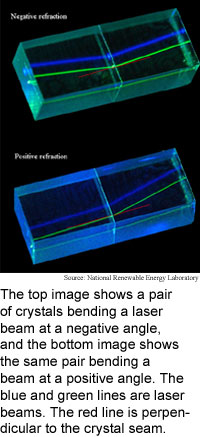
Crystal bends light back
By
Eric Smalley,
Technology Research NewsWhen light bends as it passes from one material to another, scientists assume two things will happen: some of the light will be reflected at the junction between the materials and the light that goes through will only bend at a positive angle.
Researchers at the National Renewable Energy Laboratory have shown that this is not always the case. They demonstrated that a junction in yttrium orthovanadate -- a cheap, readily available crystal -- transmits light without reflecting any of it, and is capable of guiding light and beams of electrons through a wide range of angles, both positive and negative.
In principle, the crystal can guide all types of electromagnetic radiation, including microwaves and electron beams. "Our method is applicable to any frequency of light, even electrons," said Yong Zhang, a senior scientist at the National Renewable Energy Laboratory.
The material is potentially valuable for channeling light in high-power lasers and channeling electron beams in nanoscale electronic devices.
Refraction, or the bending of light, creates the illusion that a drinking straw bends where air and water meet. Imagine a plane perpendicular to the surface of the water that intersects the surface at the point where the straw, resting at an angle, enters the water. If there were no water, the straw would appear to pass through the imaginary plane in a straight line. With water in the glass the straw still passes through the imaginary plane even though it appears to bend.
In a junction with a negative index of refraction, however, light beams bend so sharply that they do not pass through the imaginary plane, but instead appear as if they are bouncing off of an invisible mirror.
To date, only a few artificial metamaterials, for example small copper loops embedded in fiberglass boards, have shown a negative index of refraction, and then only for microwaves. Unlike the researchers crystal structure, these materials do not also show positive refraction.
Materials with a negative index of refraction are the subject of intense research because they have the potential to form super lenses that focus light more narrowly than ordinary lenses. Super lenses could be used in chip manufacturing to enable existing equipment to make smaller computer circuits.
What sets the researchers's type of crystal apart is that it has a twinning structure, which means that the orientation of the crystal's atoms on one side of the junction is the mirror image of the atomic structure on the other side. The researchers fired a laser beam through a crystal to demonstrate that the junction will refract light at both positive and negative angles, depending on the angle at which the light hits the junction.
The twinning structure exists in natural crystals, and can also be made artificially. "We use real crystals, which are readily available," said Zhang. The junctions can also be made using metamaterials constructed from rods or split rings of material.
One reason materials with negative indexes of refraction have eluded researchers is that scientists had thought that such materials could only exist if permittivity and/or permeability were negative for the material on one side of the junction. Permittivity is the ratio of the strength of an external electric field to the flow of electricity in a material. Permeability is the ratio of the strength of an external magnetic field to the magnetic force penetrating a material. The combination determines the speed at which electromagnetic energy like light passes through a material.
Neither permittivity or permeability are negative in naturally formed materials, which is why research into negative refraction has focused on developing artificial metamaterials. The permittivity and permeability of the twinning crystal structure are positive.
In most cases, negative permittivity or permeability is required, but not in all cases, as it turns out. "There are an infinite number of ways to orient the symmetry axes [of crystals]," said Zhang. "People simply couldn't search them all. Our goal was not to search for negative refraction, but to study the transmission of electrons through the twin boundary in semiconductors," he said.
The twin crystal structure could be used to channel light now, according to Zhang. It could take 10 years to develop methods of controlling electron beams, he said.
Zhang's research colleagues were Brian Fluegel and Angelo Mascarenhas. The work appeared in the October 10, 2003 issue of Physical Review Letters. The research was funded by the Department of Energy (DOE).
Timeline: Now; 10 years
Funding: Government
TRN Categories: Optical Computing, Optoelectronics and Photonics; Materials Science and Engineering; Physics
Story Type: News
Related Elements: Technical paper, "Total Negative Refraction in Real Crystals for Ballistic Electronics and Light," Physical Review Letters, October 10, 2003
Advertisements:
November 5/12, 2003
Page One
Crystal bends light backwards
Micro waterflows make power
Web game reveals market sense
Crystal fiber goes distance
Briefs:
Stored data continues to swell
Electrons spin magnetic fields
Textbook queries video
Rig fires more photon pairs
Process prints silicon circuits
Paired molecules store data

News:
Research News Roundup
Research Watch blog
Features:
View from the High Ground Q&A
How It Works
RSS Feeds:
News
Ad links:
Buy an ad link
| Advertisements:
|
 |
Ad links: Clear History
Buy an ad link
|
TRN
Newswire and Headline Feeds for Web sites
|
© Copyright Technology Research News, LLC 2000-2006. All rights reserved.